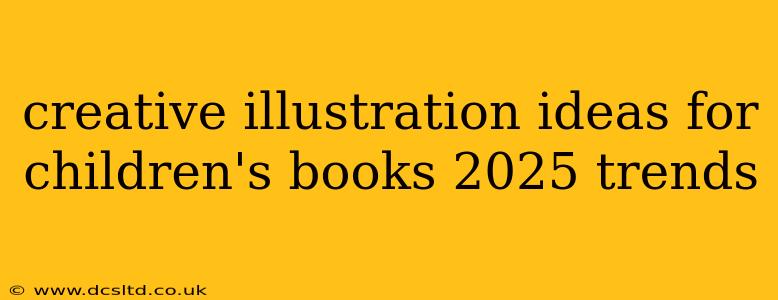Creative Illustration Ideas for Children's Books: 2025 Trends
The world of children's book illustration is constantly evolving, reflecting societal shifts and technological advancements. Looking ahead to 2025, several key trends are poised to dominate, offering exciting new avenues for creativity. This article explores these trends and provides concrete illustration ideas to inspire your next masterpiece.
H2: The Rise of Diverse and Inclusive Representation
This isn't just a trend; it's a necessity. Children's books must reflect the rich tapestry of humanity, showcasing characters from diverse ethnic backgrounds, abilities, family structures, and body types.
H3: Illustration Ideas:
- Celebrating neurodiversity: Illustrate a child with autism navigating a social situation, focusing on their unique perspective and strengths. Use visual cues to subtly communicate sensory sensitivities or different ways of processing information.
- Showcasing diverse family structures: Depict happy families headed by same-sex parents, single parents, adoptive parents, or multi-generational families. Focus on the love and support within the family unit.
- Representation beyond skin color: Go beyond simply depicting different skin tones. Illustrate characters with various hair textures, body shapes, and physical abilities, emphasizing their individuality and normalcy.
- Amplifying marginalized voices: Illustrate stories from cultures and perspectives rarely seen in mainstream children's literature, ensuring authenticity and sensitivity.
H2: Sustainability and Environmental Awareness
With growing global concern for the planet, children's books are increasingly tackling environmental themes. Illustrations can play a crucial role in communicating these messages effectively.
H3: Illustration Ideas:
- Depicting nature's beauty: Create vibrant and detailed illustrations showcasing the beauty and diversity of the natural world, emphasizing its fragility. Use bright colors and intricate details to capture the wonder of nature.
- Highlighting pollution's impact: Illustrate the negative effects of pollution on animals and the environment, using contrasting colors and imagery to create a powerful visual message.
- Showcasing sustainable practices: Illustrate children participating in eco-friendly activities like recycling, planting trees, or reducing their carbon footprint. Use warm and inviting colors to promote positive action.
- Anthropomorphic animals advocating for change: Create charming and engaging animal characters who act as environmental advocates, teaching children about conservation and sustainability.
H2: Interactive and Multi-Sensory Illustrations
Technology is transforming the way children interact with books. Illustrations are becoming more interactive and multi-sensory, incorporating elements that engage multiple senses.
H3: Illustration Ideas:
- Augmented reality (AR) integration: Design illustrations that come to life through AR apps, allowing children to interact with the characters and setting in a virtual environment.
- Hidden details and puzzles: Incorporate hidden details within the illustrations that encourage children to look closely and explore the images.
- Tactile elements: Incorporate textures into the illustrations, allowing children to feel different surfaces and materials. This could be achieved through special printing techniques or by incorporating tactile elements into the book design.
- Sound effects integration: Consider adding sound effects to the book through QR codes or similar technology, enhancing the storytelling experience.
H2: Bold and Expressive Styles
Experimentation with illustration styles will continue to be a key trend. Expect to see a mix of traditional techniques and digital approaches, with a strong emphasis on bold and expressive styles.
H3: Illustration Ideas:
- Abstract and geometric shapes: Explore the use of abstract shapes and geometric patterns to create visually engaging illustrations that appeal to young children's imaginations.
- Mixed media techniques: Combine traditional techniques like watercolor or gouache with digital elements to create unique and layered illustrations.
- Bold color palettes: Utilize vibrant and unexpected color combinations to create dynamic and engaging visuals.
- Character design with unique features: Create memorable and expressive characters through exaggerated features, unique clothing styles, and distinct personalities.
H2: Focus on Mental Health and Well-being
Children's books are increasingly addressing issues of mental health and emotional well-being. Illustrations can play a critical role in normalizing conversations about these important topics.
H3: Illustration Ideas:
- Visual metaphors for emotions: Use visual metaphors to represent complex emotions like anxiety, sadness, or anger in a way that is accessible to young children.
- Illustrating coping mechanisms: Show children using healthy coping mechanisms, such as deep breathing exercises or spending time in nature.
- Depicting characters seeking help: Normalize seeking help by illustrating characters talking to trusted adults about their feelings.
- Celebrating resilience: Focus on the power of resilience, illustrating characters overcoming challenges and finding strength within themselves.
By embracing these trends and exploring the suggested illustration ideas, you can create children's books that are not only visually stunning but also deeply meaningful and impactful. Remember that authenticity and sensitivity are paramount in portraying diverse characters and tackling sensitive topics. The future of children's book illustration is bright, full of creative potential, and ready to engage and inspire the next generation of readers.
